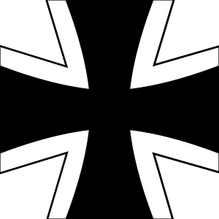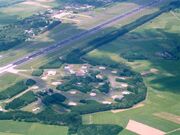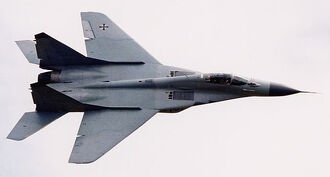Luftwaffe (German: Air Force Literally "air weapon") officially Deutsche Luftwaffe, Is the term generally used to designate the German Air Force since its creation (in 1935 by Adolf Hitler being led by Hermann Göring) And still used after WWII. Generally, the word Luftwaffe is not specific to a particular country, so being "Britische Luftwaffe" would mean "the British Air Force." The history of German military aviation forces began in 1910 with the establishment of air service and the army German Empire however was not continuous because Germany lost both world wars (1914-1918 and 1939-1945). Therefore, Germany had no military air force between 1918 and 1935 and again between 1945 and 1956.
During the WWII, The Luftwaffe played a key role in the rapid achievement of Eastern Europe and Western, And the creation of the concept of Blitzkrieg. Later, despite his best efforts could not prevent the defeat of Germany, as the Luftwaffe fought on two fronts, and the lack of replacement aircraft, thanks to constant Allied bombing of German cities and factories, and fight an enemy with greater numerical strength.
Between 1956 and 1990 there were two air forces in Germany, due to the rupture of two of Germany defeated in 1945. After reunification the Air Force East Germany was dissolved and its structure was built by the Luftwaffe. In 1999 at Kosovo, The Luftwaffe had noticed in his first action since the end of war WWII.
History
WWI
The forerunner of the Luftwaffe was founded in 1910 before the disruption of WWI and was used as an Army Air Service German Empire. The Luftstreitkräfte(Imperial Air Service). As the use of aircraft for military purposes was recent, this service was used primarily for reconnaissance and support the army on land, and before the plane, was used balloons for this purpose, as happened in Franco-Prussian War (1870-1871).
During the WWI, the Air Service Imperial Army used a variety of aircraft ranging from fighters (manufactured by Albatros

Iron Cross, a symbol of Bundeswehr and present in the planes of the Luftwaffe since First World War
Flugzeugwerke and Fokker), Reconnaissance aircraft (Aviatik and DFW) and Bombers heavy (Gothaer Waggonfabrik, Zeppelin-Staaken).
However, the fighters received more attention in the annals of military aviation, since it produced "aces" as Manfred von Richthofen, Popularly known in English as Red Baron (Red Baron), and German as Der Rote Kampfflieger (flying red-warrior), and other great drivers such as Ernst Udet, Hermann Göring, Oswald Boelcke, Max Immelmann (The first airman to win the Pour le Mérite, The highest award of the German Empire), and Werner Voss. To improve German Navy and the German Army, was also used Airships for military and civilian targets in the bombing of France, Of Belgium and United Kingdom. All military aircraft and German Austro-Hungarian in service used the emblem Iron Cross until 1918, when it was replaced by Balkenkreuz, A Greek cross, black and white. After the war ended in German defeat, the service was dissolved completely under the conditions of Versailles Treaty, Which demanded that its planes were completely destroyed. As a result of this act, the Luftwaffe is not considered the oldest independent air force in the world, while the Royal Air Force of United Kingdom is older, having been founded in April 1 of 1918.
Period between the wars
Since the ban imposed on Germany by Versailles Treaty, was prohibited the formation of an air force, but the need to train pilots for a possible future war was great. So, training was done in secret initially using schools Civil Aviation. In order to train its pilots on most modern combat aircraft, Germany requested the help of USSR. An aerodrome Secret Training was established in Lipetsk in 1924 and operated for approximately nine years, using mostly Netherlands, Russian and Germans to be closed 1933.
This base was officially known as the 4th squadron of the 40th wing of the Red Army. In February 26 of 1935, Adolf Hitler and Hermann Göring ordered to restore the Luftwaffe, breaking the Treaty of Versailles signed on 1919. Germany broke the treaty without the sanction of United Kingdom, Of France and League of Nations. However neither of the two nations, neither the League, did anything to oppose this or any other action that broke the predictions of the treaty. However, it is worth noting that before the official promulgation, the Luftwaffe was operating as a paramilitary force known as air Deutscher Luftverband (Union of the German air) and Ernst Udet as commander. Fritz Todt, The engineer who founded the Organisation Todt, Was appointed to the rank of General in the Luftwaffe. It was not, strictly speaking, an airman, although he had served in an observation squadron during WWI, Gaining Iron Cross. He died in an air strike in February 1942.
It is said that Hermann Göring personally chose an emblem for the Luftwaffe, which was different from that of other armed branches. The eagle, An old symbol of German Empire, Remained, but with a different posture. Göring refused the old heraldic eagle that seemed very stylized and static, and chose something else again, an eagle more natural and clearer, with wings spread in the position of the flight, which was more appropriate for an air force. Since 1933, when National Socialist Party of Hitler rose to power, the eagle held between his claws the symbol of the party, swastika, With two claws, while the Luftwaffe eagle held the swastika only with one claw while the other was bent in a threatening gesture.
The Luftwaffe had the ideal opportunity to test its pilots, aircraft and tactics in Spanish Civil War, when in July 1936 Hitler orders the Condor Legion to General Francisco Franco, Spanish nationalist leader, to counter the Republicans and Communists. Modern machines included names which would become world famous: the dive bomber Junkers Ju 87, Better known as Stuka, and the fighter Messerschmitt Bf 109. A systematic bombing of cities during World War II came April 1937, when a combined force of German bombers and Italian under Spanish command destroyed most of the national Basque town of Guernica, In Spain.

Bünchel's airbase
This bombing was condemned by everybody, and the collective memory of the horror of the bombing of civilians has ever since become most acute via the famous painting, named after the city name, by the Cubist artist Pablo Picasso. Many feared that this would be the way that future air wars would be conducted, and since the Italian strategist, the general Giulio Douhet, Had formulated theories regarding what would be a "strategic bombing", the idea that wars would be won by striking the air in the heart of the industrial muscle of a nation, and thus demoralizing the civilian population to the point where the government of that nation would be forced to surrender.
WWII
Since its formation before the war, the Luftwaffe was one of the most modern air forces, more powerful and experienced in the world, dominating the skies over Europe with aircraft that were more advanced than their counterparts initials. The Luftwaffe was central to the doctrine of German Blitzkrieg, because the close air support provided by dive bombers Stuka overwhelming force and a fighter for the defense were the keys to several successes later. After Battle of Britain, however, the Luftwaffe went into a steady decline, gradual. By the end of the war the Luftwaffe was no longer a major factor, and despite the advances in the field of aviation as Me 262, Was weakened by shortages of fuel, by insufficient production capacity and lack of trained pilots.
Cold War
After the war, German aviation in general was cut severely, and military aviation was forbidden when the Luftwaffe was officially

MIG-29 of LuftWaffe
disbanded by the Allies in August 1946. This changed when West Germany joined NATO in 1955, because the Western allies believe that Germany needed to have an air force in view of the growing military threat from USSR and its allies Warsaw Pact. Every plane continued to have Iron Cross the fuselage, inheritance from the days of WWI.
Many well-known fighter pilots, who had fought in the Luftwaffe in WWII, Joined the new Air Force post-war and underwent refresher training in USA before returning to West Germany. These included Erich Hartmann, The Luftwaffe pilot who shot down as many enemy planes (352), and other pilots as Gerhard Barkhorn (301) Günther Rall (275) and Johannes Steinhoff (176). Steinhoff, Suffered an air attack on a Messerschmitt Me 262 just before the war, which resulted in large scars on his face and other parts of his body. Josef Kammhuber also served with the post-war Luftwaffe, retiring in 1962 as Inspekteur der Bundesluftwaffe.
Reunification
The GDR air force, the Luftstreitkräfte der NVA, was supplied exclusively with Eastern Bloc-produced aircraft such as the Sukhoi Su-17 Fitter and Mikoyan-Gurevich (MiG) family of aircraft, such as the MiG-21 Fishbed, MiG-23 Flogger and MiG-29 Fulcrum fighters, and served primarily as an extension of Red Air Force units in Eastern Germany. The East German Air Force was unique among Warsaw Pact countries in that it was often equipped with Soviet-standard combat aircraft instead of downgraded export models. Operated as an extension of Soviet air power, the East German Air Force enjoyed less autonomy than other Eastern Bloc air forces. The markings on the aircraft reflected the identity of the country as belonging to the Communist bloc. These markings consisted of a diamond-shaped design, with three vertical stripes in black, red and gold surmounted by the stylized hammer, compass and wreath-like ears-of-grain design, which was also on the Flag of East Germany.
After last and West Germany were unified in October 1990, the aircraft of the NVA were taken over by the Federal Republic of Germany, and their GDR markings were replaced by the Iron Cross, the first time Soviet-built aircraft had served in a NATO air force. Most of these were taken out of service, in many cases being sold or given to the new Eastern European members of NATO, such as Poland and the Baltic states.
An exception to this was the ''Jagdgeschwader 73'' Steinhoff (Fighter Wing 73 "Steinhoff") stationed in Laage. The pilots of the JG 73 flew MiG-29s acquired during the reunification and were some of the most experienced MiG-29 pilots in the world. One of their primary duties was to serve as aggressor pilots, training other pilots in dissimilar combat tactics. The United States sent a group of fighter pilots to Germany during the Red October exercise to practice tactics against the aircraft they were most likely to meet in real combat. The MiG-29s of JG 73 were fully integrated into the Luftwaffe's air defence structure and, from February 1995 became the first Soviet Bloc aircraft to be declared operational within NATO. In 2004, with the introduction of the Eurofighter Typhoon imminent, the decision was taken to withdraw the MiG-29. JG 73's aircraft were withdrawn in August 2004, following which they were sold to the Polish Air Force.
1990s
The United States provides nuclear weapons for use by Germany under a NATO nuclear sharing agreement. As of 2007, only 22 B61-4s are still present, stored at Büchel Air Base for delivery with German Air Force Panavia Tornados. These bombs are likely to be withdrawn when the Tornados at Büchel are replaced with Eurofighter Typhoons after 2012, since it is not planned to integrate the B-61 bomb into the Eurofighter. B-61s stationed at Nörvenich and Memmingen Air Base (fighter-bomber wing JaBoG 34 "Allgäu") have already been withdrawn in the mid-to late-1990s. All nuclear bombs formerly stored at the Ramstein Air Base have been returned to the U.S. or elsewhere (the U.K. is possible), due to ongoing construction work at Ramstein AB, and they will not be returned to Germany.
The Balkans
The Luftwaffe saw action for first time since WWII in September 1995 during Operation Deliberate Force, when 6 IDS Tornados, equipped with infrared recce devices and escorted by 8 ECR Tornados, supported NATO's artillery missions on Bosnian Serb positions around Sarajevo. In March 1999 the Luftwaffe eventually became involved in direct combat role as part of the NATO-led Kosovo War. This event was noted as significant in the British press with "The Sun" running the headline "Luftwaffe and the RAF into battle side by side". The Luftwaffe deployed the Fighter Bomber Wing 32 which flew suppression of enemy air defence (SEAD) sorties with ECR Tornados. The fighter-bombers were equipped with an electronic countermeasures pod, a AIM-9 Sidewinder missile for self-defense and an AGM-88 HARM air to ground missile. The bomber wing flew 2108 hours and 446 sorties, firing 236 HARM missiles on enemy targets. No Luftwaffe aircraft was lost during the campaign.
2000s
In 2005 and 2008, F-4F Phantoms, in 2009 Eurofighter and F-4F participated in NATO's Baltic Air Policing operation.
In 2006, to support coalition operations across Afghanistan, the Luftwaffe deployed Panavia Tornado reconnaissance aircraft from Aufklärungsgeschwader'' 51 Immelmann (the 51st Reconnaissance Wing "Immelmann"), stationed in Mazar-i-Sharif, Northern Afghanistan. There are also various army helicopters in operation at the German air base in Mazar-i-Sharif and Luftwaffe C-160 Transall conduct air transport sorties into and within Afghanistan.
In order to counteract criticism by its ISAF allies, since December 2009 the Luftwaffe participates in combat operations of the Royal Air Force in southern Afghanistan.
See also
- History of the Luftwaffe during World War II
- Organization of the Luftwaffe during World War II
- German Air Fleets in World War II
- Glossary of German military terms
- Reich Air Ministry
- Luftstreitkräfte der NVA
- List of military aircraft of Germany
- Luftwaffenmuseum, Berlin
- List of military aircraft operational during World War II
External links
- Luftwaffe official website (German)
- The Defeat of the German Air Force, The United States Strategic Bombing Survey
- Luftwaffe museum (German) & (English)
- German Democratic Republic (1955-1990) Air Force website (German)
- Luftwaffe Resource Center - Data and photos of Luftwaffe aircraft
- Luftwaffe Fighter Pilots
- Neil Page's web site translated German pilot accounts and exclusive material on the leading Fw 190 Reich's defence Geschwader JG 300
- Luftwaffe missing-in-action (MIA) website
The original article can be found at History of the German Luftwaffe and the edit history here.